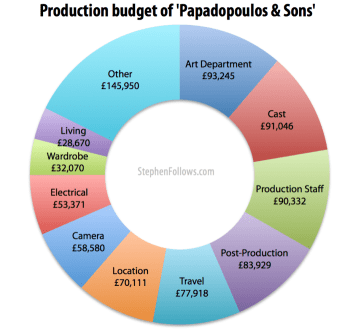Distribution experts Mick Southworth and Martin McCabe explore how the independent film sector could reap financial rewards by embracing new digital business models.
How do you get a million pounds in the bank working as a film producer?
Oh, that’s simple; start off with 10 million.
Let’s be honest. This is an industry, in the UK at least, where the film distributors, what’s left of the tax funds and international sales companies etc. do more deducting than Sherlock Holmes on his fabled seven per cent solution. Costs off the top, aligned with recoupment of advances and rights and revenue crossing, is a long-term accepted industry norm. Producers have historically concentrated on the advances that they receive in order to put together the cash they need to make the movie, and sometimes don’t spend long enough battling out the long-term arithmetic. Like puppies at Christmas, a movie isn’t just for the opening Friday night release date.
Let’s identify the crime, photofit the criminal and then work out the deterrent. First up, a hopeful young independent producer hobbles into the seedy lair of the film distributor or sales company, looking suspiciously like a wounded wildebeest at a lion convention, armed only with a flimsy script, a director, some cast and a bit of equity from his/her Aunt Doris. Ah, fresh meat!
A deal is struck whereby a percentage of the required budget is offered up on very strict terms, if certain commercial criteria can be fulfilled that might mitigate the risk profile for said distributor or sales company. ‘Now, if you can get Tom Cruise instead of that bloke from the BT advert we might be able to get you 25 per cent of the budget up to four million pounds’ is a line of reasoning that isn’t a million miles away from the truth of a typical exchange. Then of course the EIS and VCT funds swoop upon the now stricken producing creature and take their executive producer percentages of the budget for the sum they are bringing in. All the other interested parties—equity funds, mezzanine financiers, tax credit brokers, direct to DVD publishers and post houses with blended equity deals and deferrals—will then feast on what’s left of the carcass. They live well at the many world film markets too. You can bet your boots that they aren’t staying at the YMCA and bringing in homemade sandwiches when they go to Cannes…
What about the business back home? Well, a domestic distributor will classically take in first place any advance they have given, as well as their prints and advertising budget alongside their distribution fee, which can be as high as 30 per cent in some cases. Any deficits will be typically crossed and then recouped from the exploitation of all and every media over the licenced period, which normally ranges between 15 to 25 years. The cinemas take the lion’s share of the generated box office (up to 70 per cent in Blighty!).
Even if you are lucky enough to actually get the film sold to Sky or one of the free TV channels, don’t order the yacht just yet. Frankly, they are so tied up with their enormous output deals with the studios and favoured few, that the cash available for the independents is comparably modest to begin with. And with most broadcasters renegotiating these deals against a landscape of reduced major studio output on less favourable terms than previously offered, don’t expect this situation to improve.
Depressed? Don’t be. Make sure you have the best advice you can get and stay well away from those countless how-to books or two- or three-day courses on making lo-fi ‘genre’ flicks that seem to proliferate these days. Having a group of typically inexperienced producers of no-budget horror or ‘Brit gangsta’ films who have never had decent distribution or achieved anything commercially viable imparting their dubious wisdom upon you for a couple of hundred quid is both a waste of your money, and actually potentially dangerous. What you will learn invariably isn’t worth knowing.
Anyway, this could all be about to change dramatically. We know that one significant problem is the middle man culture that dominates, whether that be in distribution, state subsidies or film financing. Don’t get us wrong; people should get paid for what they achieve. The problem is that there are just too many of them operating at the centre and on the margins of a declining market, where full consideration is not always given to delivering a properly marketed product. The precipitous decline in the fortunes of the previously robust DVD sector has also played its part in accelerating a change in these long-standing business practices.
But there is partial light at the end of the tunnel. New video-on-demand platforms and distribution methodologies may liberate many an innovative producer, as the transaction is becoming increasingly direct, transparent and reasonably cost efficient against a landscape of increasingly ruinous P&A costs for independent cinema. Already a near theatrical video-on-demand window is quietly but actively being pursued by most of the majors, with speculation that one or more of the studios will start to offer a 60 – 90 day window after first theatrical release to US consumers early next year, irrespective of the discontent already opined by theatre operators in the US and UK.
The arguments for compressing these windows are driven by the twin industry shibboleths, who wish to reduce piracy and maximise the value and increasing cost of marketing films to a consumer base that has learnt to expect access to entertainment products on its own terms, and increasingly without the wearisome burden of structured release windows. These two factors are certainly dragging the studios towards a reasonable and possibly overdue contraction in these long-held practices.
Of greater interest to our argument, however, is the move within the all but moribund speciality film market towards a blended implementation of day and date releasing, making independent film releases available simultaneously in theatres, on DVD and on Video on Demand. In the US Magnolia Pictures and IFC have taken a lead, albeit abetted by their ownership of the Landmark theatre chain, with the release of a number of pictures, including two significant British productions in Neil Marshall’s erstwhile Roman epic Centurion and Monsters, the critically acclaimed sci-fi road movie hybrid. In the UK Artificial Eye and Revolver, amongst others, have attempted similar experiments in conjunction with Sky Movies to somewhat more modest results.
Another potential harbinger of change are the recent deals between DVD mail order rental service Netflix and film financier (and now distributor) Relativity and Epix, which see Netflix getting the rights to stream movies from Paramount, Lionsgate and MGM just 90 days after they debut on PPV services, in what was previously a pay television window. LoveFilm in the UK is probably 12 to 24 months behind the US with this newer ‘streaming’ window but is making up ground fast after securing deals with a number of hardware manufacturers including Sony and Samsung. In the next few years content will be increasingly available for the consumer to enjoy at home via such streaming services embedded in hardware, whether that be flat panel TVs, Blu-ray players or video game systems.
If you add that to the initiative whereby some producers are raising the required capital to be able to control their own marketing costs via existing production finance routes or through dedicated P&A funds, and then simply engaging a distribution company to apply the coalface work as an agency, you begin to see the basis of a new potential economic model for the independent film business. OK, that’s clearly not something that many can do and we still require a seminal publisher or effective marketing platform to deliver on this promise, but we are very close to being able to coordinate and implement a day-and-date multi-territory independent cinema release, complemented with comprehensive home entertainment, VOD and TV distribution from within a single distribution ‘hub’, such as the UK. And this would be at at a significantly reduced cost, with the producers and IP owners themselves taking a far greater stake in the campaign and its upstream rewards.
The worldwide digital screen network and exponential growth of online services is breaking down many of the borders of traditional production and distribution methodologies. As rights owners and creators, we could be standing at the beginning of a new and more direct route to market in offering a wider range of product and in attracting existing and new audiences in a more facile and sophisticated manner than afforded us by existing industry norms. It’s probably not great news for a whole tier of existing professional practitioners in our industry currently out there scraping a living, but this new ‘paradigm’ might finally put to rest some of the aforementioned ‘middle men’.
Technology doesn’t make our industry; ideas and stories do. But change is inevitable and this industry, certainly at the independent level, urgently needs to transform itself and come to terms with these new realities if it is to survive. If we don’t we could just find ourselves following our chum the music industry round the S-bend of business.












